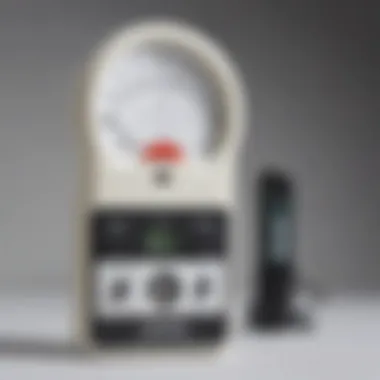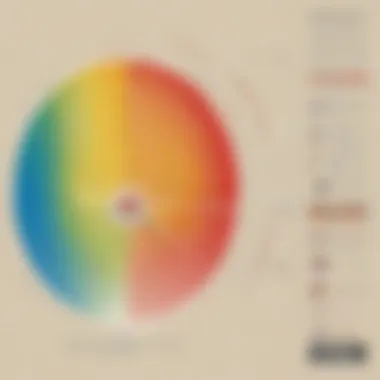Understanding Decibel Measurement for Young Scientists


Intro
Sound is all around us, influencing our lives in ways we often take for granted. Learning about how we measure sound can be both fascinating and practical for young minds. This guide navigates the world of decibels, the unit used to express the intensity of sounds, and explains why this measurement is significant in many aspects of our daily experiences.
Understanding the principles of sound measurement not only deepens scientific knowledge but also enhances awareness of the acoustic environment surrounding us. As we explore this topic, we will see how measuring sound can relate to various areas such as music, the human voice, and even environmental noise. By demystifying the technology and methods used in sound analysis, we aim to foster curiosity and inspire young scientists to explore further!
Science Fun Facts
Interesting Trivia and Facts
- Did you know that the quietest sound a human can hear is around 0 decibels? This level represents the threshold of hearing for most people.
- A whisper measures about 30 decibels, while a normal conversation is typically around 60 decibels.
- Sounds above 85 decibels can be harmful to our ears if we are exposed for long periods, such as loud music or traffic noise.
Quirky Science Stories
In the 1990s, a group of scientists attempted to measure how loud a sneeze is. They discovered that a sneeze can reach levels of 90 decibels, similar to the sound of a lawnmower! This quirky fact reminds us just how powerful everyday sounds can be.
Amazing Science Records
The loudest sound ever recorded is the Krakatoa eruption in 1883, which was measured at about 180 decibels! It could be heard over 3,000 miles away and created massive shock waves around the Earth.
Thought-Provoking Questions
- If a sound is measured at 100 decibels, how does that compare to everyday sounds?
- Why do you think understanding sound levels is important in different environments like schools, concerts, or crowded places?
Discover the Wonders of Science
Exploring Various Scientific Concepts
Exploring sound measurement opens up various scientific concepts. From the physics of sound waves to the anatomy of human hearing, each aspect provides valuable insight. Decibels are a critical point that connects these ideas, serving as a tool to quantify sound intensity.
Educational Videos and Animations
To better visualize the concept of decibels, many educational resources are available. Websites such as Britannica offer animated explanations of sound waves and how decibels fit into the larger world of physics.
Interactive Learning Tools
There are also interactive apps and websites where kids can experiment with sound levels. By providing them with the opportunity to measure sounds around them, young scientists can actively engage with their environment.
Real-Life Applications of Science
Understanding decibels has real-life implications. For example, musicians must be aware of sound levels when performing to ensure they do not damage their hearing. Environmental scientists also depend on measuring sound to study the effects of noise pollution on wildlife habitats.
Science Quiz Time
Interactive Quizzes
Test your understanding of decibels with quizzes available on educational sites. These platforms often allow students to learn while having fun through engaging questions.
Multiple Choice Questions
- What is considered a whisper in decibels?
- Sounds above how many decibels can be harmful?
- A) 10
- B) 30
- C) 50
- D) 70
- A) 60
- B) 70
- C) 85
- D) 90
Brain Teasers and Puzzles
Puzzles can include matching sounds to their corresponding decibel levels or creating scenarios that require sound level measurements. This approach incorporates both entertainment and learning.
Learning Through Gamification
Gamifying the learning process also serves as an effective approach. By framing sound measurement within game-like contexts, children can enjoy and learn simultaneously.
Science Experiment Showcase
Fun and Engaging Experiments
Encouraging young scientists to perform sound experiments can create memorable experiences. By constructing simple sound level measuring devices, they can observe sound in their world first-hand.


Step-by-Step Instructions
- Gather materials: a smartphone with a sound meter app, a ruler, and various sound sources (like clapping hands or musical instruments).
- Measure the sound levels at different distances while keeping a record.
- Discuss the results and what they indicate about sound intensity.
Materials List
- Smartphone with sound meter app
- Ruler for distance measuring
- Various sound sources
Safety Tips and Precautions
Always remind young scientists to protect their ears while conducting sound experiments, especially with louder sounds. Using ear protection can prevent potential hearing damage, especially when measuring higher decibels.
Learning about sound can open new avenues for understanding nature and our surroundings. As children explore sound measurement, they lay the foundation for a scientific mindset that encourages inquiry and discovery.
Prelims to Sound Measurement
Sound is a fundamental aspect of our environment. Understanding how to measure sound provides valuable insights not only into science but also into daily life. This section introduces the significance of sound measurement, especially through decibels, and sets the stage for young scientists to explore the world of acoustics.
When we talk about sound, it encompasses everything we hear. From a whisper to a loud explosion, the ability to measure sound levels helps us comprehend our surroundings. It allows scientists, students, and even everyday people to gain a better understanding of the effects of sound on their lives and health. Knowing how loud a sound is can influence many areas including health, safety, and environmental monitoring.
Moreover, the importance of sound measurement extends beyond just quantifying loudness. It cultivates a scientific mindset, encouraging curiosity about the physical properties of sound, its behavior in different environments, and how it interacts with various materials. Through this, young scientists learn to appreciate the nuances of sound, which can spark interest in further scientific inquiry.
In this guide, we will delve into the essentials of sound, loudness perception, and the decibel system. The knowledge gained here serves as a key building block for understanding complex acoustical concepts.
Key Elements of Sound Measurement
- Understanding Sound: What it is and how it travels.
- Loudness and Perception: How humans perceive sound intensity.
- Decibel Role: The significance of using decibels in sound measurement.
By exploring these areas, young scientists will gain confidence in their ability to measure and interpret sound in their surroundings. This introduction paves the way for deeper explorations into the fascinating and complex world of sound.
The Decibel Scale Explained
Understanding the decibel scale is crucial for grasping how we measure sound. Decibels provide a way to express sound intensity, offering a standardized measurement that is used in various fields, including music, engineering, and environmental science. In this section, we will explore three key elements: the definition of decibels, the logarithmic nature of this scale, and how different sound levels can be compared using decibels.
Decibel Definition
The term decibel is commonly used to express the intensity of sounds. One decibel is equal to one-tenth of a bel, a unit named after Alexander Graham Bell. When we say a sound is 100 decibels, we refer to it being 100 times more intense than a reference sound. This reference sound is generally the threshold of hearing, about 0 dB. Thus, sounds above this level can be louder, while those below it are quieter than what we can hear.
Logarithmic Nature of Decibels
The decibel scale is not linear but logarithmic. This means that each increase of 10 dB signifies a tenfold increase in sound intensity. For example, a sound measured at 30 dB is ten times more intense than a sound at 20 dB, and a sound at 40 dB is 100 times more intense than at 20 dB. This logarithmic nature helps us understand why seemingly small increases in measured decibels can represent significantly larger changes in sound energy.
Decibel Comparisons
When comparing sounds, decibels provide a clear framework. Here are some common reference points:
- 0 dB: Barely audible sound, like a whisper.
- 30 dB: Quiet library.
- 60 dB: Normal conversation.
- 90 dB: Loud music or chainsaw.
- 120 dB: Extreme sound level, like a jet engine at takeoff.
Understanding these comparisons can help young scientists appreciate how varied sound levels are in their environment.
The concept of the decibel scale is essential for making sense of everyday sounds, providing clarity about our auditory experiences in the world.
Tools for Measuring Sound
Understanding tools for measuring sound is crucial for grasping how we can assess noise and its impacts in various environments. Accurate measurement of sound levels is essential in many fields such as engineering, health, and media. Each tool has unique benefits, allowing users to explore sound in tangible ways. The effectiveness of these tools depends not only on their technology but also on the situation in which they are used. Young scientists should familiarize themselves with these tools as they play a key role in advancing knowledge about acoustics.
Decibel Meters
Decibel meters are specialized devices designed to measure sound levels in a quick and efficient manner. They quantify sound intensity in decibels, which helps in determining if a noise is at a safe level or if it might be harmful. These meters can range from simple handheld models to more sophisticated equipment used in professional settings.
Key features include:
- Calibration: Ensures the readings are accurate.
- Display: Shows sound levels in real-time.
- Frequency weighting: Filters noise to reflect human hearing sensitivity.
Using a decibel meter, one can easily identify loud environments, such as concerts or busy streets, and recognize safer sound levels at home or school.
"A decibel meter can help young scientists understand how loud sounds can affect their hearing health, making it an essential tool for learning about sound.
Microphones and Sound Sensors


Microphones and sound sensors can also measure sound, capturing audio signals that can be analyzed later. Unlike decibel meters, these devices convert sound waves into electrical signals, allowing for detailed study of sound. They are commonly used in recording equipment and laboratories.
They can be categorized into:
- Dynamic microphones: These are durable and good for recording loud sounds.
- Condenser microphones: Best for capturing softer sounds, often used in studios.
- Sound sensors: Devices like Raspberry Pi sound sensors can detect sound levels and can be programmed for various tasks.
Young scientists can use these tools to conduct experiments by recording different sounds in their environment and later analyzing the recordings.
Smartphone Applications
Another exciting development is the rise of smartphone applications that measure sound levels. These applications harness the built-in microphone of smartphones to provide a user-friendly sound measurement tool. While perhaps not as precise as dedicated equipment, they are accessible and can be used in real-time.
Some benefits of sound measurement apps include:
- Convenience: Easy to use anywhere.
- Immediate feedback: Users can see changes in sound levels right away.
- Data logging: Certain apps can keep records of sound levels over time.
These applications can often include additional features, such as sharing results on social media or comparing sound levels in different locations.
Types of Sound Measurements
Sound measurement is crucial for understanding how sound interacts with our environment. By knowing different methodologies for measuring sound, scientists can discern its impacts and characteristics. This section discusses three vital types of sound measurements: A-Weighted vs. C-Weighted Measurements, Peak Sound Levels, and Equivalent Continuous Level (Leq). Each type offers unique advantages and caters to different needs.
A-Weighted vs. C-Weighted Measurements
When measuring sound, A-Weighted and C-Weighted measurements serve different purposes. A-Weighted measurements filter sound to mimic the way humans hear. This method emphasizes frequencies between 1 kHz to 4 kHz, which are more sensitive to human hearing. It is often utilized in noise assessments, as it provides a realistic picture of how sound affects people.
On the other hand, C-Weighted measurements account for a broader frequency range without filtering. This method is useful for environments where low-frequency noise is significant, like in industrial or audio applications. C-Weighted measurements are beneficial when considering the performance of sound systems or when measuring loud noises.
Understanding these differences allows young scientists to select the proper measurement for their investigations, ensuring accurate results that reflect the specific characteristics of the sound being studied.
Peak Sound Levels
Peak sound level measurements refer to the maximum level of sound intensity over a specified period. This measurement is critical in recognizing potentially harmful noise and understanding sudden loud events, such as fireworks or sirens. It helps in determining if noise levels exceed safe thresholds in various environments.
For instance, when a loud noise occurs, the peak sound level can be recorded to assess its impact. Tools such as decibel meters can effectively capture this data. Young scientists might find this particularly interesting when studying events or environments with extreme sound fluctuations.
Equivalent Continuous Level (Leq)
Equivalent Continuous Level, or Leq, averages sound levels over a specified time. This measurement is especially valuable in situations where noise levels fluctuate significantly. For instance, a city street might have varying sounds throughout the day. By calculating Leq, one can understand the overall noise exposure over time, which could affect public health or well-being.
Leq is common in environmental studies, workplace assessments, and community noise evaluations. Young scientists can analyze Leq data to draw conclusions about the sound environment and its effects on different populations.
Key Takeaway: Understanding different sound measurement types enhances our ability to quantify and manage noise in our surroundings. Different methods serve distinct purposes, making it essential to choose the appropriate measurement technique for each specific sound investigation.
Applications of Sound Measurement
Sound measurement is incredibly important as it serves many purposes across different fields. By understanding how and why we measure sound, young scientists can grasp the relevance of decibels in real-world scenarios. Applications span from environment concerns to ensuring media quality, and safety regulations at work. Each area highlights how sound affects our daily lives in various ways.
Environmental Monitoring
Environmental monitoring refers to tracking sound levels in the ecosystem. It helps scientists understand how noise pollution affects habitats and wildlife. Certain animals rely on sound for communication, hunting, or escaping predators. For example, if a forest has too much noise, birds may find it hard to communicate. This would impact their mating or feeding habits. By measuring sound in neighborhoods, forests, and oceans using decibel meters, we can figure out how loud is too loud.
Another important aspect is how sound travels through different environments. Urban areas often have higher sound levels, caused by traffic, construction, and human activity. This can be detrimental to both people and wildlife. Through environmental monitoring, city planners and conservationists can make more informed decisions about zoning and noise regulations.
Understanding noise pollution is essential for sustaining healthy ecosystems and communities.
Sound Quality in Media
In the media sector, sound quality is crucial for a good experience. Whether it's in movies, video games, or music, sound plays a key role in how each medium communicates its message. Proper sound levels enhance clarity and immersion, making viewers or listeners feel more connected. Measuring sound ensures that music is not too loud, or dialogue is not drowned out by background noise.
Different media types require specific sound measurements. For example, a concert requires a different approach compared to a film. Using A-weighted decibels helps sound engineers ensure the audio quality fits the experience intended. Tools like microphones assist in capturing the best sound, while meters help control it.
Workplace Safety and Noise Regulations
Workplace safety is another critical application of sound measurement. Many jobs involve exposure to loud noises, which can cause hearing loss over time. Regulations exist to protect workers, and keeping sound levels within safe limits is part of that. Companies are required to measure sound levels in their environment and take action if they exceed safety guidelines.
The Occupational Safety and Health Administration (OSHA) has established permissible noise exposure limits. Regular monitoring using specialized equipment helps ensure compliance. If sound levels are too high, businesses must implement changes, such as using quieter machines or installing sound barriers.
Understanding Noise Pollution


Noise pollution is becoming an increasingly important topic as urbanization and technology advance. In this article, we will explore what noise pollution is, how it affects our health, and the ways we can regulate it. Understanding noise pollution is essential for young scientists as it not only relates to sound measurement but also ties into environmental science and human health.
What is Noise Pollution?
Noise pollution refers to unwanted or harmful sound that is disruptive to daily life. This can include sounds from traffic, construction sites, loud music, or industrial operations. These noises can accumulate in our environment and become a background that many do not notice, yet they have significant effects on our surroundings. According to research, noise is defined as any sound that is loud, unpleasant, or harmful to human ears.
Common sources of noise pollution include:
- Traffic: Cars, trucks, motorcycles, and airplanes contribute to high noise levels in urban areas.
- Industrial Activities: Factories and plants often produce loud sounds due to machinery.
- Construction Work: Drills and heavy machines emit constant noise as buildings are erected or repaired.
Impact on Health
The impact of noise pollution on health is a significant concern. Exposure to high levels of noise can lead to various health problems. Studies have shown that constant noise can cause:
- Hearing Loss: Prolonged exposure to loud sounds can damage our hearing, sometimes permanently.
- Stress and Anxiety: Unwanted sounds can lead to increased levels of stress, which can affect overall well-being.
- Sleep Disturbances: Noisy environments can disrupt sleep patterns, leading to fatigue and decreased concentration during the day.
According to the World Health Organization, noise pollution can lead to other serious health issues like heart disease. Understanding these effects can motivate young scientists to think more critically about noise in their environments and advocate for quieter communities.
Regulating Noise Levels
Regulating noise levels is crucial to combat noise pollution and protect health. Governments and organizations often put regulations in place to limit excessive noise. Some of these regulations include:
- Noise Ordinances: Local laws can restrict noise levels during certain hours to prevent disturbance at night.
- Noise Barriers: Structures made of walls or vegetation can help block sound from roads or railways from reaching residential areas.
- Soundproofing: Buildings can be designed with materials meant to minimize sound transmission, offering relief from external noise.
Individuals can also play a role in reducing noise pollution. Being aware of personal noise contributions and using quieter operating tools can help. For example, when playing music or hosting events, keeping sound at a reasonable level can maintain a peaceful environment.
"Understanding noise pollution is key to creating healthier living spaces for everyone."
Exploring Sound in Everyday Life
Understanding the role of sound in our daily environment provides valuable insights into how we interact with the world around us. Sound is everywhere, influencing our experiences and emotions. For young scientists, recognizing and measuring sound can lead to a greater awareness of their surroundings, enhancing their curiosity and engagement with science.
Common Sources of Sound
Sound originates from numerous sources in our lives. Common sources include:
- Nature: Wind rustling through leaves, birds chirping, and the sound of rain.
- Human Activity: Conversations, laughter, music, and various forms of entertainment.
- Transportation: Cars, trains, airplanes, and bicycles contribute significantly to sound pollution.
- Household Appliances: Refrigerators, air conditioners, and vacuum cleaners are constant producers of sound.
Identifying these sources helps young scientists understand the different ways sound is generated. Each source has a unique sound level, affecting how we perceive it.
Sound Levels in Different Environments
Sound levels can vary greatly depending on the environment. For instance, a quiet library may register around 40 decibels, while a busy street can exceed 80 decibels. Here are some notable environments and their approximate sound levels:
- Quiet Room: 30-40 dB
- Conversation: 60-70 dB
- Lawn Mower: 90 dB
- Rock Concert: 110 dB
Young scientists should learn to measure and compare these levels. Understanding how sound behaves in diverse settings cultivates critical thinking skills.
Participating in Sound Measurement Activities
Engaging in sound measurement activities can be an excellent way for young scientists to grasp the concept of decibels. Here are some suggested activities:
- Decibel Meter Use: Measure sound levels in various locations, such as parks, schools, or home.
- Sound Journals: Create a journal tracking sounds heard throughout the day, noting their sources and levels.
- Group Experiments: Work in pairs or groups to measure sounds, compare findings, and discuss results.
These activities encourage observation and analysis, key components of the scientific method. Through participation, young scientists can enhance their understanding of sound measurement and its significance.
Epilogue
The conclusion of this article plays a crucial role in summarizing the key themes discussed throughout the guide. It encapsulates the essence of sound measurement, particularly focusing on decibels, and reinforces the understanding that sound is not just a basic phenomenon but a complex topic rich with applications.
In review, understanding decibel measurement is vital for young scientists as it equips them with foundational knowledge useful in diverse fields such as environmental science, engineering, and health. Gaining a grasp on how sound levels are measured helps in recognizing the importance of noise control in everyday life. Moreover, it encourages responsible observation of one's surroundings by fostering awareness about the auditory experiences we encounter.
Recap of Key Concepts
The journey through sound measurement has highlighted several critical points.
- Sound's Nature: Sound travels in waves and is affected by various environmental factors.
- Loudness and Decibels: Decibels are the unit of measurement that express sound intensity. Understanding their logarithmic scale clarifies why small changes can mean significant differences in perception.
- Practical Measurement Tools: Many tools exist for measuring sound, including decibel meters and smartphone applications, making the study of sound accessible.
- Noise Pollution's Impact: The discussion on noise pollution illustrated its adverse effects on health and well-being, stressing the need for regulation.
- Everyday Sound Experiences: It emphasized common sources of sound and how sound levels change in various environments.
This recap serves as a consolidation of the valuable insights provided in the article, reinforcing how this knowledge empowers young readers to become informed about their auditory environments.
Encouragement to Explore Further
As we conclude, it is essential to inspire young budding scientists to delve deeper into the fascinating world of sound. Encouragement to explore further can be transformative; investigating sound can lead to significant discoveries.
- Experimentation: Try measuring sound levels around your home and neighborhood. Use tools like smartphone applications or even DIY sound level testers.
- Research Projects: Engage in school projects regarding noise pollution and environmental studies. Understanding local soundscapes can promote community awareness and action.
- Visit Science Centers: Many science museums have interactive exhibits about sound and acoustics. Engaging with these tools can enhance understanding and spark interest.
"The pursuit of knowledge is never-ending; the mind always needs fresh ideas and challenges."







